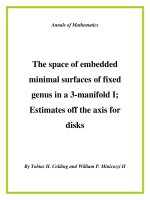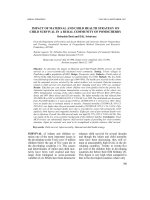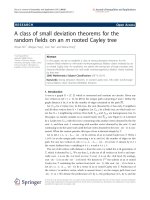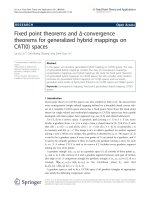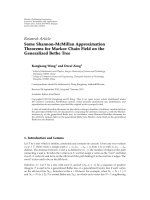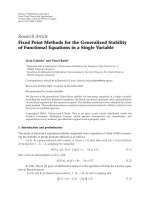Vanishing theorems for L2 harmonic 1forms on complete submanifolds in a Riemannian manifold
Bạn đang xem bản rút gọn của tài liệu. Xem và tải ngay bản đầy đủ của tài liệu tại đây (838.37 KB, 16 trang )
JID:YJMAA
AID:18972 /FLA
Doctopic: Miscellaneous
[m3L; v1.143-dev; Prn:5/11/2014; 17:24] P.1 (1-16)
J. Math. Anal. Appl. ••• (••••) •••–•••
Contents lists available at ScienceDirect
Journal of Mathematical Analysis and Applications
www.elsevier.com/locate/jmaa
Vanishing theorems for L2 harmonic 1-forms on complete
submanifolds in a Riemannian manifold
Nguyen Thac Dung a , Keomkyo Seo b,∗
a
Department of Mathematics, Mechanics, and Informatics (MIM), Hanoi University of Sciences
(HUS–VNU), Vietnam National University, 334 Nguyen Trai Str., Thanh Xuan, Hanoi, Vietnam
b
Department of Mathematics, Sookmyung Women’s University, Hyochangwongil 52, Yongsan-ku,
Seoul, 140-742, Republic of Korea
a r t i c l e
i n f o
a b s t r a c t
Article history:
Received 30 June 2014
Available online xxxx
Submitted by H.R. Parks
Let M be an n-dimensional complete orientable noncompact hypersurface in a
complete Riemannian manifold of nonnegative sectional curvature. For 2 ≤ n ≤ 6,
we prove that if M satisfies the δ-stability inequality (0 < δ ≤ 1), then there is
no nontrivial L2β harmonic 1-form on M for some constant β. We also provide
sufficient conditions for complete hypersurfaces to satisfy the δ-stability inequality.
Moreover, we prove a vanishing theorem for L2 harmonic 1-forms on M when M is an
n-dimensional complete noncompact submanifold in a complete simply-connected
Riemannian manifold N with sectional curvature KN satisfying that −k2 ≤ KN ≤ 0
for some constant k.
© 2014 Elsevier Inc. All rights reserved.
Keywords:
δ-Stability inequality
L2 harmonic 1-form
Traceless second fundamental form
First eigenvalue
1. Introduction
Let M n be an n-dimensional orientable minimal hypersurface in a Riemannian manifold N of nonnegative
sectional curvature. We recall that a minimal hypersurface in a Riemannian manifold is called stable provided
the second variation of the volume is nonnegative for any normal variation on a compact subset. More
precisely, a minimal hypersurface M in a Riemannian manifold N is said to be called stable if for any
f ∈ C0∞ (M )
|∇f |2 − |A|2 + Ric(ν, ν) f 2 dv ≥ 0,
(1.1)
M
where A is the second fundamental form, Ric is the Ricci curvature of N , ν is the unit normal vector of M ,
and dv is the volume form on M .
* Corresponding author.
E-mail addresses: (N.T. Dung), (K. Seo).
URL: (K. Seo).
/>0022-247X/© 2014 Elsevier Inc. All rights reserved.
JID:YJMAA
2
AID:18972 /FLA
Doctopic: Miscellaneous
[m3L; v1.143-dev; Prn:5/11/2014; 17:24] P.2 (1-16)
N.T. Dung, K. Seo / J. Math. Anal. Appl. ••• (••••) •••–•••
On the other hand, for a number 0 < δ ≤ 1, it is called δ-stable if any function f ∈ C0∞ (M ) satisfies
|∇f |2 − δ |A|2 + Ric(ν, ν) f 2 dv ≥ 0.
(1.2)
M
It is obvious that δ1 -stability implies δ2 -stability for 0 < δ2 < δ1 ≤ 1. In particular, if M is stable, then M
is δ-stable for 0 < δ ≤ 1.
There have been plenty of works on δ-stable complete minimal hypersurfaces in a Riemannian manifold.
(See [3,8,10,19,27] and references therein for more details.) It is well-known that the only complete orientable
stable minimal surface in R3 is a plane [4,7]. For 1/8 < δ, Kawai [15] showed that a δ-stable complete
minimal surface in R3 should be a plane. Furthermore, do Carmo and Peng [5] proved that if a stable
complete minimal hypersurface M in the Euclidean space with M |A|2 dv < ∞, then M is a hyperplane.
Later, Shen and Zhu [26] proved that an n-dimensional stable complete minimal hypersurface M in the
Euclidean space with M |A|n dv < ∞ is a hyperplane. Recently, Tam and Zhou proved that a complete
n−2
n -stable minimal hypersurface whose second fundamental form satisfies some decay conditions in the
Euclidean space is either a hyperplane or a catenoid.
In case of complete orientable stable minimal hypersurfaces, several results on the nonexistence of L2
harmonic forms are well-known. Palmer [22] proved that if there exists a codimension one cycle on a complete
minimal hypersurface M in the Euclidean space which does not separate M , then M is unstable by using the
nonexistence of L2 harmonic 1-form. Thereafter, using Bochner’s vanishing technique, Miyaoka [20] showed
that a complete orientable noncompact stable minimal hypersurface in a nonnegatively curved manifold has
no nontrivial L2 harmonic 1-forms. In [32], Yun proved that if M ⊂ Rn+1 is a complete minimal hypersurface
with sufficiently small total scalar curvature M |A|n , then there is no nontrivial L2 harmonic 1-form on M .
Yun’s result has been generalized into various ambient spaces [2,6,23–25].
For an n-dimensional complete orientable noncompact (not necessarily minimal) hypersurface M in a
complete manifold N of nonnegative sectional curvature with 2 ≤ n ≤ 4, Kim and Yun [16] recently proved
that if M satisfies the stability inequality (1.1), then there is no nontrivial L2 harmonic 1-form on M ,
which is an extension of a well-known fact in the case when M is a complete stable minimal hypersurface
in N . In Section 2, motivated by this, we prove that if M is an n-dimensional complete noncompact (not
necessarily minimal) hypersurface in a complete manifold N of nonnegative sectional curvature and M
satisfies the δ-stability inequality (1.2) for a number 0 < δ ≤ 1, then there is no nontrivial L2β harmonic
1-form on M for some constant β. (See Theorem 2.6 for more details.) As a consequence, we extend
Kim and Yun’s result into the case when n = 5, 6. In Section 3, we also provide sufficient condition for
complete hypersurfaces to satisfy the δ-stability inequality in a Riemannian manifold. In Section 4, we deal
with complete noncompact submanifold cases. For an n-dimensional complete noncompact submanifold
M in a complete simply-connected Riemannian manifold N with sectional curvature KN satisfying that
−k2 ≤ KN ≤ 0 for some constant k, it turns out that if the L2 norm φ n of the traceless second fundamental
form φ is sufficiently small and the first eigenvalue λ1 (M ) of the Laplacian is bigger than some constant
depending only on k, n, and φ n , then there is no nontrivial L2 harmonic 1-form on M .
2. Harmonic 1-forms on complete hypersurfaces of lower dimensions
A complete manifold M is called non-parabolic if it has a positive Green function. Otherwise, M is called
parabolic. We note that M is non-parabolic provided it has a non-constant positive superharmonic function
on M . The following sufficient condition for parabolicity is well-known.
Theorem. (See [11,12,14,28].) Let M be a complete manifold. If, for any point p ∈ M and a geodesic ball
Bp (r) ⊂ M ,
JID:YJMAA
AID:18972 /FLA
Doctopic: Miscellaneous
[m3L; v1.143-dev; Prn:5/11/2014; 17:24] P.3 (1-16)
N.T. Dung, K. Seo / J. Math. Anal. Appl. ••• (••••) •••–•••
∞
3
r
dr = ∞,
Vol(Bp (r))
1
then M is parabolic.
Using the above theorem, we see that if M is non-parabolic, then
∞
r
dr < ∞,
Vol(Bp (r))
(2.1)
1
and hence M has an infinite volume.
Definition 2.1. Let M n be an n-dimensional orientable hypersurface in a Riemannian manifold N . We say
the δ-stability inequality holds on M for 0 < δ ≤ 1 if any f ∈ C0∞ (M ) satisfies
|∇f |2 − δ |A|2 + Ric(ν, ν) f 2 dv ≥ 0.
M
It turns out that a complete orientable noncompact hypersurface in a complete manifold with nonnegative
sectional curvature has an infinite volume if the δ-stability inequality holds for 0 < δ ≤ 1.
Lemma 2.2. Let M n be a complete orientable noncompact hypersurface in a complete manifold N with
nonnegative sectional curvature. If the δ-stability inequality holds on M for 0 < δ ≤ 1, then the volume of
M is infinite.
Proof. If M is non-parabolic, then M has an infinite volume by (2.1). We now assume that M is parabolic.
Given 0 < δ ≤ 1, since the δ-stability inequality holds on M , we have
|∇ϕ|2 ≥ δ
M
Ric(ν, ν) + |A|2 ϕ2
M
for any f ∈ C0∞ (M ).
Let q := δ(|A|2 + Ric(ν, ν)) and let D ⊂ M be any bounded domain with smooth boundary. Denote
by λq1 (D) the first eigenvalue of the Schrödinger operator Δ + q acting on functions vanishing on ∂D.
The assumption that the δ-stability holds on M is equivalent to that λq1 (D) ≥ 0 for any bounded domain
D ⊂ M . From the result in [7], it follows that there is a positive function u such that the equation
Δu + qu = 0 on M . Since the sectional curvature of N is nonnegative, u is a positive superharmonic
function on M . The parabolicity of M implies that u is constant. Hence |A| ≡ 0, which shows that M is
totally geodesic in N . Thus M has nonnegative Ricci curvature, which gives the conclusion that M has an
infinite volume [31]. ✷
Let M n be an n-dimensional orientable submanifold in an (n + p)-dimensional Riemannian manifold
N
. Fix a point x ∈ M and choose any local orthonormal frame {e1 , · · · , en+p } such that {e1 , · · · , en } is
an orthonormal basis of the tangent space Tx M and {en+1 , · · · , en+p } is an orthonormal basis of the normal
space Nx M . For each α ∈ {n + 1, · · · , n + p}, define a linear map Aα : Tx M → Tx M by
n+p
¯ X Y, eα ,
Aα X, Y = ∇
JID:YJMAA
AID:18972 /FLA
Doctopic: Miscellaneous
[m3L; v1.143-dev; Prn:5/11/2014; 17:24] P.4 (1-16)
N.T. Dung, K. Seo / J. Math. Anal. Appl. ••• (••••) •••–•••
4
¯ denotes the Levi-Civita connection on N . Then the (unwhere X, Y are tangent vector fields and ∇
normalized) mean curvature vector H is defined by
n+p
H=
(trace Aα )eα .
α=n+1
Define a linear map φα : Tx M → Tx M by
φα X, Y = Aα X, Y − X, Y H, eα
and a traceless bilinear map φ : Tx M × Tx M → Nx M by
n+p
φ(X, Y ) =
φα X, Y eα .
α=n+1
This map φ is called the traceless second fundamental form of M . Denote by A the second fundamental
form. Then
|φ|2 = |A|2 −
H2
.
n
Note that
H2
≤ n.
|A|2
In particular, if p = 1, then
φ=A−
H
g,
n
where g is the induced metric on M .
Lemma 2.3. Let b :=
√
(n−2)2 n−1
√
.
2n( n−1+1)2
Then we have
√
2(n − 1)|H|2 − (n − 2) n − 1|H|
n|A|2 − |H|2 ≥ −bn2 |A|2 .
(2.2)
Proof. If |A| = 0, then H = 0. Thus the inequality (2.2) is trivial. Now we assume that |A| > 0. The
inequality (2.2) is equivalent to
√
(n − 2) n − 1 |H|
n2
|A|
We define fn (t) on [0,
√
n−
H2
2(n − 1) H 2
−
≤ b.
|A|2
n2
|A|2
n ] by
√
(n − 2) n − 1
fn (t) =
t
n2
n − t2 −
2(n − 1) 2
t .
n2
Suppose that there is a positive constant B such that B ≥ max[0,√n ] fn (t). Then
√
(n − 2) n − 1t
n − t2 ≤ 2(n − 1)t2 + Bn2 ,
∀t ∈ [0,
√
n]
JID:YJMAA
AID:18972 /FLA
Doctopic: Miscellaneous
[m3L; v1.143-dev; Prn:5/11/2014; 17:24] P.5 (1-16)
N.T. Dung, K. Seo / J. Math. Anal. Appl. ••• (••••) •••–•••
5
or equivalently,
(n − 2)2 (n − 1)x(n − x) ≤ 4(n − 1)2 x2 + 4B(n − 1)n2 x + B 2 n4 ,
(2.3)
where x := t2 for all x ∈ [0, n]. A simple computation shows that the inequality (2.3) holds true if
√
(n − 2)2 n − 1
√
B≥
= b,
2n( n − 1 + 1)2
which gives the conclusion. ✷
In the following, we need the Ricci curvature estimate for submanifolds in a Riemannian manifold which
was done by Leung [17].
Lemma 2.4. (See [17].) Let M be an n-dimensional submanifold in a Riemannian manifold N with sectional
curvature KN satisfying that K ≤ KN where K is a constant. Then the Ricci curvature RicM of M satisfies
RicM ≥ (n − 1)K +
√
1
2(n − 1)|H|2 − (n − 2) n − 1|H|
n2
n|A|2 − |H|2
−
n−1 2
|A| .
n
Using Lemma 2.3 and the above Ricci curvature estimate, one can obtain the following.
Lemma 2.5. Let M n be a complete orientable noncompact hypersurface in N of nonnegative sectional curvature. Then
√
RicM ≥ −
n−1 2
|A| .
2
(2.4)
Proof. By Lemma 2.3 and Lemma 2.4, we see
RicM
√
(n − 2)2 n − 1
n−1
√
|A|2
+
≥−
n
2n( n − 1 + 1)2
√
n−1 2
|A| ,
=−
2
which completes the proof. ✷
Theorem 2.6. Let M n (2 ≤ n ≤ 6) be a complete orientable noncompact hypersurface in a complete manifold
n−2
N with nonnegative sectional curvature. If the δ-stability inequality holds on M for some 2 √
≤ δ ≤ 1,
n−1
2β
then there is no nontrivial L harmonic 1-form on M for any constant β satisfying
√
2δ
1−
n−1
1−
n−2
√
2δ n − 1
<β< √
2δ
1+
n−1
Proof. We will prove Theorem 2.6 by using Fu–Yang’s arguments [10].
Let ω be an L2β harmonic 1-form on M . Then
|ω|2β dv < ∞.
Δω = 0 and
M
1−
n−2
√
2δ n − 1
.
JID:YJMAA
AID:18972 /FLA
6
Doctopic: Miscellaneous
[m3L; v1.143-dev; Prn:5/11/2014; 17:24] P.6 (1-16)
N.T. Dung, K. Seo / J. Math. Anal. Appl. ••• (••••) •••–•••
We shall use the same notation ω for a harmonic 1-form and its dual harmonic vector field in an abuse of
notation. Bochner’s formula implies
Δ|ω|2 = 2 |∇ω|2 + RicM (ω, ω) .
On the other hand, it follows that
Δ|ω|2 = 2 |ω|Δ|ω| + ∇|ω|
2
.
Thus we obtain
2
|ω|Δ|ω| − RicM (ω, ω) = |∇ω|2 − ∇|ω| .
Since the Kato-type inequality
|∇ω|2 − ∇|ω|
2
≥
1
∇|ω|
n−1
2
holds for any harmonic 1-form ω on an n-dimensional Riemannian manifold [29],
|ω|Δ|ω| ≥
1
∇|ω|
n−1
2
+ RicM (ω, ω).
(2.5)
Applying Lemma 2.5, we get
1
∇|ω|
|ω|Δ|ω| ≥
n−1
√
2
−
n−1 2 2
|A| |ω| .
2
Given any α > 0, we have
|ω|α Δ|ω|α = |ω|α α(α − 1)|ω|α−2 ∇|ω|
α−1
∇|ω|α
α
α−1
≥
∇|ω|α
α
=
2
2
+ α|ω|α−1 Δ|ω|
+ α|ω|2α−2 ω|Δ|ω
√
1
n−1 2 2
2
∇|ω| −
|A| |ω|
+ α|ω|
n−1
2
√
n−2
n − 1 2 2α
α 2
∇|ω|
|A| |ω| .
−α
1−
(n − 1)α
2
≥
2
2α−2
(2.6)
Choose any nonnegative number q and a smooth function φ with compactly support in M . Multiplying
both sides of the inequality (2.6) by |ω|2qα φ2 and integrating over M , we obtain
1−
n−2
(n − 1)α
≤
|ω|
|ω|2qα φ2 ∇|ω|α
M
(2q+1)α 2
M
=α
√
√
α
φ Δ|ω| + α
2
n−1
2
|A|2 φ2 |ω|2(q+1)α
M
n−1
2
M
−2
φ|ω|(2q+1)α ∇φ, ∇|ω|α .
M
2
|ω|2qα ∇|ω|α φ2
|A|2 φ2 |ω|2(q+1)α − (2q + 1)
M
JID:YJMAA
AID:18972 /FLA
Doctopic: Miscellaneous
[m3L; v1.143-dev; Prn:5/11/2014; 17:24] P.7 (1-16)
N.T. Dung, K. Seo / J. Math. Anal. Appl. ••• (••••) •••–•••
7
Hence
2(q + 1) −
√
≤α
n−2
(n − 1)α
n−1
2
2
|ω|2qα ∇|ω|α φ2
M
|ω|2(q+1)α |A|2 φ2 − 2
M
φ|ω|(2q+1)α ∇φ, ∇|ω|α .
(2.7)
M
On the other hand, since M satisfies the δ-stability inequality and N has nonnegative sectional curvature,
we have
|∇φ|2 ≥ δ
M
Ric(ν, ν) + |A|2 φ2 ≥ δ
M
|A|2 φ2 .
M
Replacing φ by |ω|(1+q)α φ in the above inequality gives
2
|ω|2qα ∇|ω|α φ2 +
|ω|2(q+1)α |A|2 φ2 ≤ (q + 1)2
δ
M
M
|ω|2(q+1)α |∇φ|2
M
|ω|(2q+1)α φ ∇φ, ∇|ω|α .
+ 2(1 + q)
(2.8)
M
Combining (2.7) and (2.8), we obtain
2(q + 1) −
≤
α
δ
+
√
n−2
(n − 1)α
2
|ω|2qα ∇|ω|α φ2
M
n−1
(q + 1)2
2
2α
δ
√
2
|ω|2qα ∇|ω|α φ2 +
M
|ω|2(q+1)α |∇φ|2
M
n−1
(q + 1) − 2
2
|ω|(2q+1)α φ ∇φ, ∇|ω|α .
(2.9)
M
Given ε > 0, the Schwarz inequality implies
2α
δ
√
n−1
(q + 1) − 2
2
≤ 1−
α
δ
√
|ω|(2q+1)α φ ∇φ, ∇|ω|α
M
n−1
(q + 1)
2
2|ω|(2q+1)α φ|∇φ| ∇|ω|α
M
2
|ω|2qα ∇|ω|α φ2 +
≤ |D| ε
M
1
ε
|ω|2(q+1)α |∇φ|2 ,
M
where
α
D := 1 −
δ
√
n−1
(q + 1).
2
(2.10)
JID:YJMAA
AID:18972 /FLA
Doctopic: Miscellaneous
[m3L; v1.143-dev; Prn:5/11/2014; 17:24] P.8 (1-16)
N.T. Dung, K. Seo / J. Math. Anal. Appl. ••• (••••) •••–•••
8
From the inequalities (2.9) and (2.10), it follows that
2(q + 1) −
√
≤
n−2
−
(n − 1)α
n−1α
2
δ
√
n − 1 α(q + 1)2
2
δ
2
|ω|2qα ∇|ω|α φ2
M
|ω|2(q+1)α |∇φ|2
M
2
|ω|2qα ∇|ω|α φ2 +
+ |D|ε
|D|
ε
M
|ω|2(q+1)α |∇φ|2 ,
M
or equivalently,
2(q + 1) −
√
≤
n−2
−
(n − 1)α
√
n − 1 α(q + 1)2
− |D|ε
2
δ
2
|ω|2qα ∇|ω|α φ2
M
n − 1 α |D|
+
2
δ
ε
|ω|2(q+1)α |∇φ|2 .
(2.11)
M
Now let β := (1 + q)α and choose the numbers α and q such that
n−2
−
2(q + 1) −
(n − 1)α
√
n − 1 α(q + 1)2
> 0.
2
δ
Therefore, for a sufficiently small ε > 0, the inequality (2.11) implies that there is a constant C > 0 which
depends on ε, δ, q, α such that
2
|ω|2qα ∇|ω|α φ2 ≤ C
M
|ω|2β |∇φ|2 ,
(2.12)
M
provided that
n−2
−
2(q + 1) −
(n − 1)α
√
n − 1 α(q + 1)2
> 0.
2
δ
(2.13)
Note that the inequality (2.13) is equivalent to
n−2
−
2β −
n−1
√
n − 1 β2
> 0,
2
δ
which is satisfied by the assumption
√
2δ
1−
n−1
1−
2δ
n−2
√
n−1
<β< √
2δ
1+
n−1
1−
2δ
n−2
√
n−1
.
Given R > 0 and a fixed point p ∈ M , we take a test function φ(r) defined on [0, ∞) such that φ ≥ 0, φ = 1
on [0, R] and φ = 0 in [2R, ∞) with |φ | ≤ R2 , where r(x) denotes the distance from p to x on M . Then the
inequality (2.12) becomes
|ω|2qα ∇|ω|α
M
2
≤
4C
R2
|ω|2β .
M
JID:YJMAA
AID:18972 /FLA
Doctopic: Miscellaneous
[m3L; v1.143-dev; Prn:5/11/2014; 17:24] P.9 (1-16)
N.T. Dung, K. Seo / J. Math. Anal. Appl. ••• (••••) •••–•••
9
Letting R → ∞, we conclude that |ω| is constant since ω is an L2β harmonic 1-form. However, since the
volume of M is infinite by Lemma 2.2, we obtain that ω ≡ 0, which completes the proof. ✷
As a direct consequence of Theorem 2.6, if δ = 1, that is, M satisfies the stability inequality (1.1), we
have the following.
Corollary 2.7. For 2 ≤ n ≤ 6, let M n be a complete orientable noncompact hypersurface in a complete
manifold N with nonnegative sectional curvature. Let α1 and b be the same constants as in Theorem 2.6.
If the stability inequality (1.1) holds on M , then there is no nontrivial L2β harmonic 1-form on M for any
constant β satisfying
√
2
1−
n−1
1−
n−2
√
2 n−1
<β< √
2
1+
n−1
1−
n−2
√
2 n−1
.
√
Moreover, if we take (n−1)2n n−1 < δ ≤ 1 in Theorem 2.6, we have the following vanishing theorem for L2
harmonic 1-forms on such hypersurfaces M .
Corollary 2.8. For 2 ≤ n ≤ 6, let M n be a complete orientable noncompact hypersurface in a complete
√
manifold N with nonnegative sectional curvature. If M satisfies δ-stability inequality for some (n−1)2n n−1 <
δ ≤ 1, then there is no nontrivial L2 harmonic 1-form on M .
Proof. Taking β = 1 in Theorem 2.6 and using our assumption that
√
2δ
1−
n−1
1−
n−2
√
2δ n − 1
<1< √
2δ
1+
n−1
√
(n−1) n−1
2n
1−
< δ ≤ 1, we see
n−2
√
2δ n − 1
.
Applying Theorem 2.6 gives the conclusion. ✷
We remark that Corollary 2.7 and Corollary 2.8 can be regarded as extensions of the main result in [16].
For higher codimensional cases, we define the δ-super stability inequality as follows.
Definition 2.9. Let M n be an n-dimensional orientable submanifold in the (n + p)-dimensional Euclidean
space Rn+p . We say the δ-super stability inequality holds on M for 0 < δ ≤ 1 if any f ∈ C0∞ (M ) satisfies
|∇f |2 − δ|A|2 f 2 dv ≥ 0.
M
The definition of super stability in the Euclidean space was introduced by Q. Wang [30]. In particular,
when p = 1 and δ = 1, the concept of super stability is the same as the usual definition of stability. Using
the same arguments as in the proof of Theorem 2.6, we obtain the following.
n+p
Corollary 2.10. Let M n (2 ≤ n ≤ 6) be a complete
. If the δ-super
√ orientable noncompact submanifold in R
(n−1) n−1
2
stability inequality holds on M for some
< δ ≤ 1, then there is no nontrivial L harmonic 1-form
2n
on M .
3. Sufficient conditions for complete hypersurfaces to satisfy the δ-stability inequality
Given a complete noncompact Riemannian manifold M , we consider a compact domain Ω ⊂ M . Let
λ1 (Ω) > 0 denote the first eigenvalue of the Dirichlet boundary value problem
JID:YJMAA
AID:18972 /FLA
Doctopic: Miscellaneous
[m3L; v1.143-dev; Prn:5/11/2014; 17:24] P.10 (1-16)
N.T. Dung, K. Seo / J. Math. Anal. Appl. ••• (••••) •••–•••
10
Δf + λf = 0
f =0
in Ω
on ∂Ω
where Δ denotes the Laplace operator on M . By the domain monotonicity principle, the first eigenvalue
λ1 (M ) of a complete noncompact manifold M is defined by
λ1 (M ) = inf λ1 (Ω),
Ω
where the infimum is taken over all compact domains in M .
In this section, we provide sufficient conditions for an n-dimensional complete hypersurface to satisfy the
δ-stability inequality. More precisely, we prove that if the Ln or L∞ norm of the second fundamental form
is sufficiently small in terms for an n-dimensional complete hypersurface M in a Riemannian manifold with
nonpositive sectional curvature, then the δ-stability inequality holds on M .
Theorem 3.1. Let M be an n-dimensional complete hypersurface in a Riemannian manifold N with sectional
curvature KN satisfying that KN ≤ K ≤ 0 where K ≤ 0 is a constant. Assume that for 0 < δ ≤ 1
|A|2 ≤
λ1 (M )
− nK.
δ
Then the δ-stability inequality holds on M .
Proof. The assumption on the sectional curvature on N implies that Ric(ν, ν) ≤ nK. Since for any f ∈
C0∞ (M )
λ1 (M ) ≤
|∇f |2
,
f2
M
M
it follows from the assumption on |A|2 that
|∇f |2 − δ |A|2 + Ric(ν, ν) f 2 ≥
M
λ1 (M ) − δ|A|2 + nK f 2 ≥ 0.
M
Therefore the δ-stability inequality on M holds for any 0 < δ ≤ 1. ✷
It is well known that the following Sobolev inequality holds on a complete submanifold in a complete
simply-connected manifold with nonpositive sectional curvature.
Lemma 3.2. (See [13].) Let M n (n ≥ 3) be an n-dimensional complete submanifold in a complete simplyconnected manifold with nonpositive sectional curvature. Then for any φ ∈ W01,2 (M ) we have
|φ|
M
2n
n−2
n−2
n
dv
2
≤ CS
|∇φ|2 + φ|H| dv,
(3.1)
M
where CS is the Sobolev constant which depends only on n ≥ 3.
Using the above Sobolev inequality (3.1), one obtains another sufficient condition for a complete hypersurface in a complete simply connected Riemannian manifold to have the δ-stability inequality.
JID:YJMAA
AID:18972 /FLA
Doctopic: Miscellaneous
[m3L; v1.143-dev; Prn:5/11/2014; 17:24] P.11 (1-16)
N.T. Dung, K. Seo / J. Math. Anal. Appl. ••• (••••) •••–•••
11
Theorem 3.3. Let M n (n ≥ 3) be an n-dimensional complete hypersurface in a complete simply connected
Riemannian manifold N with nonpositive sectional curvature. Assume that for 0 < δ ≤ 1
2
n
|A|
n
≤
1
,
(n + δ)CS
M
where CS is a Sobolev constant in (3.1). Then the δ-stability inequality holds on M .
Proof. From the Sobolev inequality (3.1) and Hölder inequality, it follows that for any f ∈ C0∞ (M ),
|f |
2n
n−2
n−2
n
≤ CS
M
|∇f |2 + f |H|
2
M
≤ CS
|∇f | + CS
M
2
n
|H|
2
n
|f |
M
n−2
n
2n
n−2
.
M
Thus
|f |
2n
n−2
n−2
n
CS
1 − CS H
≤
M
2
n
|∇f |2 ,
M
since
H
2
n
≤n A
2
n
≤
n
1
<
(n + δ)CS
CS
by our assumption. Therefore
1 − CS H
|∇f | − δ |A| + Ric(ν, ν) f ≥
CS
2
2
2
2
n
|f |
M
2n
n−2
n−2
n
−δ
M
≥
1 − CS H
CS
2
n
|A|2 f 2
M
−δ A
|f |
2
n
2n
n−2
n−2
n
M
≥
1 − nCS A
CS
2
n
−δ A
2n
|f | n−2
2
n
n−2
n
M
≥
1
− (n + δ) A
CS
2n
|f | n−2
2
n
n−2
n
M
≥ 0,
which gives the conclusion. ✷
4. Vanishing theorem for L2 harmonic 1-forms on complete noncompact submanifolds
As mentioned in the introduction, there are several vanishing theorems for L2 harmonic forms on complete
noncompact stable minimal hypersurfaces. Recall that ω is an L2 harmonic 1-form on M if it satisfies
Δω = −(dδ + δd)ω = 0 and
|ω|2 < ∞.
M
JID:YJMAA
12
AID:18972 /FLA
Doctopic: Miscellaneous
[m3L; v1.143-dev; Prn:5/11/2014; 17:24] P.12 (1-16)
N.T. Dung, K. Seo / J. Math. Anal. Appl. ••• (••••) •••–•••
Even without assuming stability of minimal hypersurfaces, if M ⊂ Rn+1 is a complete minimal hypersurface
with sufficiently small quantity of M |A|n , then we still have a vanishing theorem for L2 harmonic 1-forms
on M . (See [21,25,32] for details.) The analogue of this result is also true for a complete minimal hypersurface
in hyperbolic space [24]. Later, it turned out that these gap theorems hold for more general submanifolds.
Given an n-dimensional complete noncompact submanifold in Euclidean space, Carron [1] proved that there
exists a constant c(n) such that if |A| ≤ c(n), then all spaces of L2 harmonic forms are trivial. Fu and Li [9]
showed that for a complete noncompact submanifold M n ⊂ RN there also exists a constant d(n) such that
if the Ln norm of the traceless second fundamental form φ is less than d(n) then there is no nontrivial L2
harmonic 1-form on M .
More generally, let M be an n-dimensional complete noncompact submanifold in a complete simplyconnected Riemannian manifold N with sectional curvature KN satisfying −k2 ≤ KN ≤ 0 for some
constant k. In [2], Cavalcante, Mirandola and Vitório recently proved that if the Ln norm of the traceless second fundamental form φ is sufficiently small and if the first eigenvalue λ1 (M ) of the Laplacian
satisfies
(n − 1)2 2
k − inf |H|2 ,
n
λ1 (M ) >
then there is no nontrivial L2 harmonic 1-form on M . Note that the lower bound of λ1 (M ) depends on
inf |H| in their result.
In this section, we prove a similar vanishing theorem for L2 harmonic 1-forms on complete noncompact
submanifolds under the same assumptions as in [2] except that the lower bound of λ1 (M ) depends on φ n .
More precisely, we prove
Theorem 4.1. Let M n (n ≥ 3) be an n-dimensional complete noncompact submanifold in a complete simplyconnected Riemannian manifold N with sectional curvature KN satisfying that −k2 ≤ KN ≤ 0 where k is
a constant. Assume that the traceless second fundamental form φ satisfies
φ
n
<
1
.
n(n − 1)CS
In the case k = 0, assume further that the first eigenvalue λ1 (M ) of M satisfies
λ1 (M ) >
2n2 (n − 1)2 k2
n3 − (n − 2)(n − 1) n(n − 1)CS φ
n
− 2n(n − 1)CS φ
2
n
,
where CS is a Sobolev constant in (3.1). Then there is no nontrivial L2 harmonic 1-form on M .
Proof. As in the proof of Theorem 2.6, it follows from the inequality (2.5) that for any harmonic
1-form ω
|ω|Δ|ω| ≥
1
∇|ω|
n−1
2
+ RicM (ω, ω).
Moreover, using Lemma 2.4 and the fact that |φ|2 = |A|2 −
Ric ≥ (n − 1)
|H|2
− k2
n2
−
n−2
n2
|H|2
n ,
we see
n(n − 1)|φ||H| −
n−1 2
|φ| .
n
JID:YJMAA
AID:18972 /FLA
Doctopic: Miscellaneous
[m3L; v1.143-dev; Prn:5/11/2014; 17:24] P.13 (1-16)
N.T. Dung, K. Seo / J. Math. Anal. Appl. ••• (••••) •••–•••
13
Combining these two inequalities, we have
1
∇|ω|
n−1
|ω|Δ|ω| ≥
−
n−2
n2
2
+ (n − 1)
|H|2
− k2 |ω|2
n2
n−1 2 2
|φ| |ω| .
n
n(n − 1)|φ||H||ω|2 −
(4.1)
Consider a geodesic ball B(R) of radius R centered at x ∈ M . Choose a test function f satisfying 0 ≤ f ≤ 1,
f ≡ 1 on B(R), f ≡ 0 on M \ B(2R), and |∇f | ≤ R1 . Multiplying both sides by a compactly supported
function f 2 in BR ⊂ M and integrating over BR , we have
1
2
∇|ω| f 2 +
n−1
f 2 |ω|Δ|ω| ≥
BR
BR
|H|2
− k2 |ω|2 f 2
n2
(n − 1)
BR
n−2
n2
−
n−1 2 2 2
|φ| |ω| f .
n
n(n − 1)|φ||H||ω|2 f 2 −
BR
BR
Applying the divergence theorem, we have
0 ≤ −2
f |ω| ∇f, ∇|ω| −
BR
+
n−2
n2
n(n − 1)
n
n−1
2
∇|ω| f 2 +
n−1
n
BR
|φ|2 |ω|2 f 2
BR
|φ||H||ω|2 f 2 + (n − 1)
BR
k2 −
|H|2
|ω|2 f 2 .
n2
BR
For any positive numbers α, β > 0, it follows from the Schwarz inequality
≤α
f |ω| ∇f, ∇|ω|
2
BR
f 2 ∇|ω|
2
+
BR
1
α
|∇f |2 |ω|2
(4.2)
BR
and
|φ||H||ω|2 f 2 ≤ β
2
BR
|H|2 |ω|2 f 2 +
1
β
BR
|φ|2 |ω|2 f 2 .
BR
Combining these inequalities, we obtain
0≤
α−
+
n
n−1
f 2 ∇|ω|
2
+
BR
β(n − 2)
2n2
1
α
|∇f |2 |ω|2
BR
n(n − 1) −
n−1
n2
|H|2 |ω|2 f 2
BR
+
n−2
2βn2
n(n − 1) +
n−1
n
|φ|2 |ω|2 f 2
BR
+ k2 (n − 1)
BR
|ω|2 f 2 .
(4.3)
JID:YJMAA
AID:18972 /FLA
Doctopic: Miscellaneous
[m3L; v1.143-dev; Prn:5/11/2014; 17:24] P.14 (1-16)
N.T. Dung, K. Seo / J. Math. Anal. Appl. ••• (••••) •••–•••
14
Similarly, we have the following estimate:
|φ| |ω| f ≤
2
2
n
|φ|
2 2
n
BR
|ω||f |
BR
n−2
n
2n
n−2
BR
≤ CS
2
n
|φ|
n
2
∇ |ω|f
BR
BR
BR
2
n
|φ|n
≤ CS
|H|2 |ω|2 f 2
+
f 2 ∇|ω|
(1 + α)
BR
2
+ 1+
1
α
BR
2
n
|φ|n
+ CS
BR
|∇f |2 |ω|2
BR
|H|2 |ω|2 f 2 .
(4.4)
BR
In the case k = 0, we need an additional estimate. Using the monotonicity of the first eigenvalue λ1 (BR ) of
a ball BR , we observe that
BR
λ1 (M ) ≤ λ1 (BR ) ≤
|∇f |2
BR
(4.5)
f2
for any f ∈ C0∞ (M ). Putting |ω|f for f in the inequality (4.5) and using the Schwarz inequality (4.2) gives
f 2 ∇|ω|
|ω|2 f 2 ≤ (1 + α)
λ1 (M )
BR
2
1
α
+ 1+
|∇f |2 |ω|2 .
BR
(4.6)
BR
Combining the inequalities (4.3), (4.4) and (4.6), we have
f 2 ∇|ω|
A
2
|H|2 |ω|2 f 2 ≤ C
+B
BR
BR
|∇f |2 |ω|2 ,
(4.7)
BR
where the constants A, B, C are defined by
k2 (n − 1)
n
−α−
+ CS
A=
n−1
λ1 (M )
B=
n−1 n−2
−
n2
2n2
|φ|
n
2
n
n−2
2βn2
n(n − 1) +
n−1
n
(1 + α)
BR
n(n − 1)β − CS
|φ|n
2
n
n−2
2βn2
n(n − 1) +
n−1
n
BR
C=
1
k2 (n − 1)
+
+ CS
α
λ1 (M )
|φ|n
2
n
n−2
2βn2
n(n − 1) +
n−1
n
1+
1
.
α
BR
Using our assumption on φ
n
and the following arithmetic–geometric mean inequality
β + CS φ
2
n
1
≥ 2 CS φ
β
n,
(4.8)
√
we see that B > 0 for any β > 0. Take β = CS φ n which makes equality in the inequality (4.8). By
the assumptions on λ1 (M ) and φ n , we can choose the number α > 0 small enough such that A > 0.
Furthermore, it automatically follows that C > 0.
JID:YJMAA
AID:18972 /FLA
Doctopic: Miscellaneous
[m3L; v1.143-dev; Prn:5/11/2014; 17:24] P.15 (1-16)
N.T. Dung, K. Seo / J. Math. Anal. Appl. ••• (••••) •••–•••
15
Now letting R → ∞ in the inequality (4.7), we obtain |∇|ω|| ≡ 0 and |H||ω| ≡ 0. Since |∇|ω|| ≡ 0, we
get |ω| ≡ constant. Suppose that |ω| is a nonzero constant. From the fact that |H||ω| ≡ 0, it follows that M
is a minimal submanifold. However, since the volume of a complete minimal submanifold in a Riemannian
manifold of nonpositive sectional curvature is infinite, we have M |ω|2 = ∞. This is a contradiction to the
assumption that ω is an L2 harmonic 1-form. Therefore ω ≡ 0, which completes the proof. ✷
As a consequence, if the ambient space N is the Euclidean space, we obtain the following result.
Corollary 4.2. Let M n (n ≥ 3) be an n-dimensional complete noncompact submanifold in the Euclidean
space RN . If the traceless second fundamental form φ satisfies
φ
n
1
,
n(n − 1)CS
<
then there is no nontrivial L2 harmonic 1-form on M .
It immediately follows from the above result that such M must have only one end. We remark that
the upper bound of φ n is less than the upper bound in Corollary 1.1 of [2], which is nonetheless a
generalization of [9] and [18]. Moreover, when the ambient space N has a pinched nonpositive sectional
curvature, we immediately obtain the following.
Corollary 4.3. Let M n (n ≥ 3) be an n-dimensional complete noncompact submanifold in a complete simplyconnected Riemannian manifold N with sectional curvature KN satisfying that −k2 ≤ KN ≤ 0 for some
constant k = 0. If
φ
n
<
1
n(n − 1)CS
and
λ1 (M ) >
2n2 (n − 1)2 k2
,
n3 − n2 + 3n − 4
then there is no nontrivial L2 harmonic 1-form on M .
We remark that the upper bound of φ n and the lower bound of λ1 (M ) depend only on the dimension
of M and the curvature of the ambient space, which is different from [2].
Acknowledgments
The authors would like to thank the referee for the helpful comments and suggestions. The first author
was supported in part by NAFOSTED under grant number 101.02-2014.49. A part of this paper was written during a stay of the first author at Vietnam Institute for Advanced Study in Mathematics (VIASM).
He would like to express his sincerely thanks to staffs there for excellent working conditions and financial
support. The second author was supported in part by Basic Science Research Program through the National Research Foundation of Korea (NRF) funded by the Ministry of Science, ICT and Future Planning
(NRF-2013R1A1A1A05006277).
JID:YJMAA
AID:18972 /FLA
16
Doctopic: Miscellaneous
[m3L; v1.143-dev; Prn:5/11/2014; 17:24] P.16 (1-16)
N.T. Dung, K. Seo / J. Math. Anal. Appl. ••• (••••) •••–•••
References
[1] G. Carron, L2 -cohomologie et inegalites de Sobolev, Math. Ann. 314 (4) (1999) 613–639.
[2] M.P. Cavalcante, H. Mirandola, F. Vitório, L2 harmonic 1-forms on submanifolds with finite total curvature, J. Geom.
Anal. 24 (1) (2014) 205–222.
[3] T.H. Colding, W.P. Minicozzi II, The space of embedded minimal surfaces of fixed genus in a 3-manifold. II. Multi-valued
graphs in disks, Ann. of Math. 160 (2004) 69–92.
[4] M. do Carmo, C.K. Peng, Stable complete minimal surfaces in R3 are planes, Bull. Amer. Math. Soc. (N.S.) 1 (1979)
903–906.
[5] M. do Carmo, C.K. Peng, Stable complete minimal hypersurfaces, in: Proc. Beijing Symp. Differential Equations and
Differential Geometry, vol. 3, 1980, pp. 1349–1358.
[6] N.T. Dung, K. Seo, Stable minimal hypersurfaces in a Riemannian manifold with pinched negative sectional curvature,
Ann. Global Anal. Geom. 41 (4) (2012) 447–460.
[7] D. Fischer-Colbrie, R. Schoen, The structure of complete stable minimal surfaces in 3-manifolds of nonnegative scalar
curvature, Comm. Pure Appl. Math. 33 (1980) 199–211.
[8] H.P. Fu, The structure of δ-stable minimal hypersurface in Rn+1 , Hokkaido Math. J. 40 (2011) 103–110.
[9] H.P. Fu, Z.Q. Li, L2 harmonic 1-forms on complete submanifolds in Euclidean space, Kodai Math. J. 32 (3) (2009) 432–441.
[10] H.P. Fu, D.Y. Yang, Vanishing theorems on complete manifolds with weighted Poincaré inequality and applications,
Nagoya Math. J. 206 (2012) 25–37.
[11] A. Grigor’yan, On the existence of a Green function on a manifold, Uspekhi Mat. Nauk 38 (1) (1983) 161–162 (in Russian);
Engl. transl. in Russian Math. Surveys 38 (1) (1983) 190–191.
[12] A. Grigor’yan, On the existence of positive fundamental solution of the Laplace equation on Riemannian manifolds, Mat.
Sb. 128 (3) (1985) 354–363 (in Russian); Engl. transl. in Math. USSR Sb. 56 (1987) 349–358.
[13] D. Hoffman, J. Spruck, Sobolev and isoperimetric inequalities for Riemannian submanifolds, Comm. Pure Appl. Math. 27
(1974) 715–727.
[14] L. Karp, Subharmonic functions, harmonic mappings and isometric immersions, in: S.T. Yau (Ed.), Seminar on Differential
Geometry, in: Ann. of Math. Stud., vol. 102, Princeton University Press, Princeton, 1982.
[15] S. Kawai, Operator Δ − aK on surfaces, Hokkaido Math. J. 17 (2) (1988) 147–150.
[16] J.J. Kim, G. Yun, On the structure of complete hypersurfaces in a Riemannian manifold of nonnegative curvature and L2
harmonic forms, Arch. Math. (Basel) 100 (2013) 369–380.
[17] P.F. Leung, An estimate on the Ricci curvature of a submanifold and some applications, Proc. Amer. Math. Soc. 114
(1992) 1051–1063.
[18] Y.W. Li, X.W. Xu, J.R. Zhou, The complete hypersurfaces with zero scalar curvature in Rn+1 , Ann. Global Anal. Geom.
44 (4) (2013) 401–416, />[19] W.H. Meeks III, J. Perez, A. Ros, Liouville-type properties for embedded minimal surfaces, Comm. Anal. Geom. 14 (4)
(2006) 703–723.
[20] R. Miyaoka, L2 harmonic 1-forms on a complete stable minimal hypersurface, Geom. Global Anal. (1993) 289–293.
[21] L. Ni, Gap theorems for minimal submanifolds in Rn+1 , Comm. Anal. Geom. 9 (3) (2001) 641–656.
[22] B. Palmer, Stability of minimal hypersurfaces, Comment. Math. Helv. 66 (1991) 185–188.
[23] K. Seo, Minimal submanifolds with small total scalar curvature in Euclidean space, Kodai Math. J. 31 (1) (2008) 113–119.
[24] K. Seo, Rigidity of minimal submanifolds in hyperbolic space, Arch. Math. (Basel) 94 (2) (2010) 173–181.
[25] K. Seo, L2 harmonic 1-forms on minimal submanifolds in hyperbolic space, J. Math. Anal. Appl. 371 (2) (2010) 546–551.
[26] Y. Shen, X. Zhu, On stable complete minimal hypersurfaces in Rn+1 , Amer. J. Math. 120 (1998) 103–116.
[27] L.F. Tam, D. Zhou, Stability properties for the higher dimensional catenoid in Rn+1 , Proc. Amer. Math. Soc. 137 (10)
(2009) 3451–3461.
[28] N.T. Varopoulos, Potential theory and diffusion of Riemannian manifolds, in: Conference on Harmonic Analysis in Honor
of Antoni Zygmund, vols. I, II, in: Wadsworth Math. Ser., Wadsworth, Belmont, CA, 1983, pp. 821–837.
[29] X. Wang, On conformally compact Einstein manifolds, Math. Res. Lett. 8 (5–6) (2001) 671–688.
[30] Q. Wang, On minimal submanifolds in an Euclidean space, Math. Nachr. 261/262 (2003) 176–180.
[31] S.T. Yau, Some function-theoretic properties of complete Riemannian manifolds and their applications to geometry, Indiana
Univ. Math. J. 25 (1976) 659–670.
[32] G. Yun, Total scalar curvature and L2 harmonic 1-forms on a minimal hypersurface in Euclidean space, Geom. Dedicata
89 (2002) 135–141.


